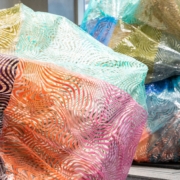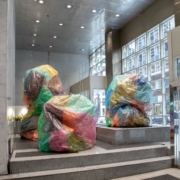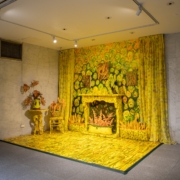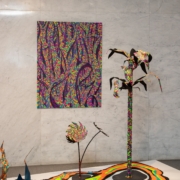125 Maiden Lane – New York, New York
March 13, 2023 – November 12, 2023
Art-in-Buildings is pleased to announce two new exhibitions opening in the atrium and lobby of 125 Maiden Lane, Charlotte Becket: Interference and Phaan Howng: Rise of the Machines Plants.
Charlotte Becket’s kinetic sculptures explore the interplay of the analogue and digital world – using mechanical methods and physical materials to create surfaces that mimic what we find in electronic displays. For her installation at 125 Maiden Lane, Interference, Becket draws on the optical effect of moiré patterns that can be unintentionally produced in digital imagery, print, or video. This type of visual distortion occurs when two semitransparent, patterned layers are misaligned and pass over each other – the slight offset error creates an illusion of movement.
Interference takes over the atrium space with three brightly colored monolithic sculptures that grow from the platform, rising to eleven feet tall. The exterior of the works is covered in layers of patterned “skins” that create a surface that seemingly moves as the eye tries to register and focus. Pushing the hallucinogenic effect further, Becket inserts mechanical elements inside the sculptures which slowly and rhythmically move the surface of the piece to create a physically and visually living piece.
As Becket describes, “This work explores the illusionistic potential of physical materials, the translation between digital and analogue processes, and the conceptual implications of a visually erratic composition, the result of a minor error in calibration. In their construction, these works physically replicate digital information distortion, misrepresentation, and miscommunication.”
For Phaan Howng’s latest installation, Rise of the Machines Plants, she continues her exploration of the relationship between horticulture and the ecological conditions brought on by globalization and capitalism. On one side of the lobby at 125 Maiden Lane, brightly hand-painted wallpaper, paintings, and sculptures create a Victorian-style parlor that is overtaken by flora that has evolved to camouflage into its surroundings. Originally displayed at Dinner Gallery, the installation refers to the origins of the rare and exotic plant market that arose due to imperialism during the Victorian Era. Opposite the Victorian-style parlor, a hyper-abstracted neon rug serves as a toxic, unnatural landscape from which plants and flora grow as if they are adapting and evolving from an earth corrupted by chemicals and waste.
Historically, pseudo-scientific newspapers crafted tales about killer plants as a tactic to create curiosity about non-native flora. The powerful influence of the headlines led to the creation of the genre of gothic horror and fiction that has remained popular into the modern era. Echoing a gothic horror storyline, Howng’s killer plants fight back after being controlled, exploited, and colonized by mankind. In neon colors and abstract forms, they use camouflage to adapt to their environment, a radioactive landscape where only the plants survive.
As the climate crisis unfolds before us, Howng urges us to confront toxic ecological practices in hopes of creating a more environmentally thoughtful and truly sustainable future.
_____________________________
Charlotte Becket lives and works in New York City where she is an Associate Professor at Pace University. She attended Hunter College’s MFA program. Solo and two-person exhibitions include LaMama Galleria, New York City, Valentine Gallery NY, Crisp Gallery in London, LEAP in Berlin, Taxter and Spengemann in New York City as well as group exhibitions at Gazelli Art House in London, Gasser and Grunert, Anna Kustera, NY Studio Gallery, Passerby and the Invitational Exhibition Academy of Arts and Letters in New York City. She has been invited to lecture on her work at various galleries and universities and has been the recipient of grants from The New York Foundation for the Arts, Socrates Sculpture Park, The Joan Mitchell Foundation, The Tony Smith Foundation, the Verizon Foundation, and the Center for Book Arts. Her work has been reviewed in The New York Times, TimeOut London, ArtForum, and Art in America, among others, and included in the publication, 100 Artists, a compendium of interviews with 100 international contemporary artists by Francesca Gavin.
Phaan Howng is a Taiwanese American artist who creates large-scale paintings, site-specific installations that center around the Earth defensively brandishing its landscape in a post-human future. She incorporates theatrical and cinematic elements in her work to place the viewer in an idealized or satirical speculative future to encourage reflection on current environmental and ecological conditions fostered by extractive global capitalism. Her research into landscape theory, anthropology, and history grounds these interrogations of Western concepts of nature, the human, and time. Howng currently lives and works in Baltimore, Maryland. She received her BFA from Boston University and her MFA from the Mt. Royal School of Art at MICA. Her works have been exhibited at the Asian Arts and Culture Center at Towson University in Maryland, MoCA Arlington in Virginia, the Baltimore Museum of Art in Maryland and the Smithsonian Institution in Washington, DC. She has completed multiple large-scale commissions including installations for Facebook and American Express, and her work has been featured in notable publications such as The New York Times T List, The American Scholar, Bmore Art Magazine, and Artnet.
For press inquiries contact: QUINN | TEI@quinn.pr | 212.868.1900
________________________________________
Image left: Charlotte Beckett, detail of Interference, 2023. Courtesy the artist.
Image right: Phaan Howng, Rise of the Machines Plants, 2023. Courtesy the artist.
Charlotte Becket: Interference and Phaan Howng: Rise of the Machines Plants is curated by Tessa Ferreyros with Tara Oluwafemi and sponsored by Time Equities Inc. (TEI) Art-in-Buildings. TEI is committed to enriching the experience of our properties through the Art-in-Buildings Program, an innovative approach that brings contemporary art by emerging and mid-career artists to non-traditional exhibition spaces in the interest of promoting artists, expanding the audience for art, and creating a more interesting environment for our building occupants, residents, and guests.






















